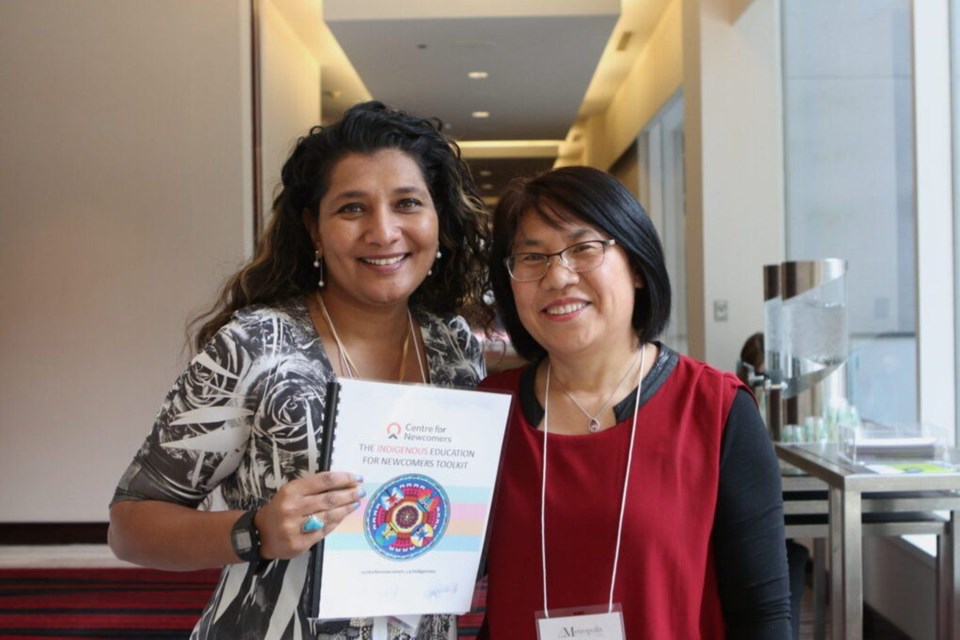VANCOUVER - If educating newcomers about Indigenous peoples and their history in Canada is the goal, then the approach must recognize that there are more similarities than differences among them.
That’s one of the main takeaways that Anila Umar Lee Yuen, the president and CEO of the Centre for Newcomers (CFN), learned over the past two years while developing the CFN’s first-of-its-kind “Indigenous Education for Newcomers” toolkit.
The toolkit helps participants engage in various dialogue and storytelling activities “to create bridges of understanding and appreciation on both sides,” explained Lee Yuen during the first day of the 24th Metropolis Canada Conference in Vancouver, British Columbia, on March 24.
“If we focus too much on the differences — that was our teaching for us — we can get lost in the weeds,” she said, referring to the fact that members of the two groups often face similar experiences of racism, lack of access to social services, poverty and other social ills, as multiple reports have stated.
“That was really important: to start with the similarities, build a trust, build a relationship, and then the sticky conversations will happen. But they can happen in a sacred space and a space of trust.”
The toolkit is the culmination of the CFN’s unique response to action number 93 of the Truth and Reconciliation Commission of Canada’s 94 calls to action.
The 93rd call to action calls on the Federal government to work with Indigenous organizations to revamp “the information kit for newcomers to Canada and its citizenship test” to “reflect a more inclusive history of the diverse Aboriginal peoples of Canada, including information about the Treaties and the history of residential schools.”
“What could any settlement agency or newcomer-serving group or ethnocultural community group…use to…understand this information and be able to build connections themselves?” Lee Yuen said. “It just culminated into this.”
Self-education
The first part of CFN’s Indigenous education program, which was created at the end of 2016 with seed funding from a family foundation, Lee Yuen said, consisted of educating themselves in the history of Indigenous Peoples.
As a result, “the majority of the money,” she said, was spent on hiring University of Calgary professors “that were in the Indigenous relations department or were Indigenous themselves.”
One of those professors was Dustin Louie of the University of Calgary, who is a First Nations scholar from Nee Tahi Buhn and Nadleh Whut’en of the Carrier Nation in central B.C.
“(Louie) did a lot of work with us on what it means to Indigenize, or what are Indigenous ways of being,” said Lee Yuen.
Cindy Provost, the Aboriginal liaison at the Calgary Police Service, was also hired in 2020 as the CFN’s vice president of Indigenous relations.
“We did a Google search, and we couldn’t find any other settlement agency that has a leadership team member that is Indigenous doing Indigenous relations,” said Lee Yuen. “We’re really proud of being able to do that work as well.”
Lee Yuen describes the toolkit, which was finalized this year, as “the culmination of two years of really hard work with the advisory committee.”
Elders advice
In 2020, the Elders Council was established with the help of Blackfoot Elder Casey Eaglespeaker. It consisted of a male and female elder from each of the seven First Nation groups in Treaty 7, located in southern Alberta.
But one year after creating the Elders Council, the Indigenous elders approached CFN staff with one concern: the lack of newcomer elders and their voices on the consultation committee.
“If it’s for newcomers and Indigenous community, why are you only asking Indigenous elders and not newcomer elders for their wisdom?” Lee Yuen recalls the elders asking.
“And why are our peers not with us, so it can be a mutual learning and understanding?”
That’s what led the CFN to introduce five newcomer elders from Calgary to the committee in 2021.
“Because elders have different connotations in different cultures, what the criteria we went by was ‘who is somebody in the community – doesn’t necessarily need to hold title – but is somebody people go to when they’re in crisis or when they need wisdom or comfort,’” said Lee Yuen.
Indigenous Voices in the Classroom
The workshop concluded with Sally Zhao, the CEO of The Immigrant Education Society (TIES), discussing the organization’s Indigenous Voices in the Classroom (IVC) project, a partnership with CFN.
The program “aims to address the historic prejudice and discrimination that has silenced Indigenous people in every region of Canada and alienated our Indigenous and non-Indigenous communities,” said Zhao.
“(IVC) encourages newcomers to build relationships with Indigenous communities and avoid the traditional societal prejudice affecting Canadian society today.”
IVC’s curriculum developers at TIES and CFN also worked with Indigenous elders and community members in Alberta, Saskatchewan and B.C. to bring the program to life. Elders informed curriculum developers that they would like to see newcomers learn about their history, their teaching and the atrocities committed at Canada’s residential schools.
“It connects real people and their stories, so newcomers can build knowledge and insight into successes and challenges that communities face today,” said Zhao.
The curriculum is divided into two booklets, both designed for two separate levels of the Canadian Language Benchmark (CLB), the national standard for describing and measuring the English language proficiency of adult immigrants and prospective newcomers. Both explore diverse Indigenous languages, arts, traditions, clothes, music and people.
Both Lee Yuen and Zhao said formulating such educational programs and curricula could not have been achieved without close collaboration and partnership with Indigenous groups.
“You can’t do this work without the community that you’re in saying, ‘Yes, this is something we want to participate in,’” said Lee Yuen.
Zhao agreed, saying, quite simply, if curricula about Indigenous education are developed without Indigenous input, “you can never find the truth.”




